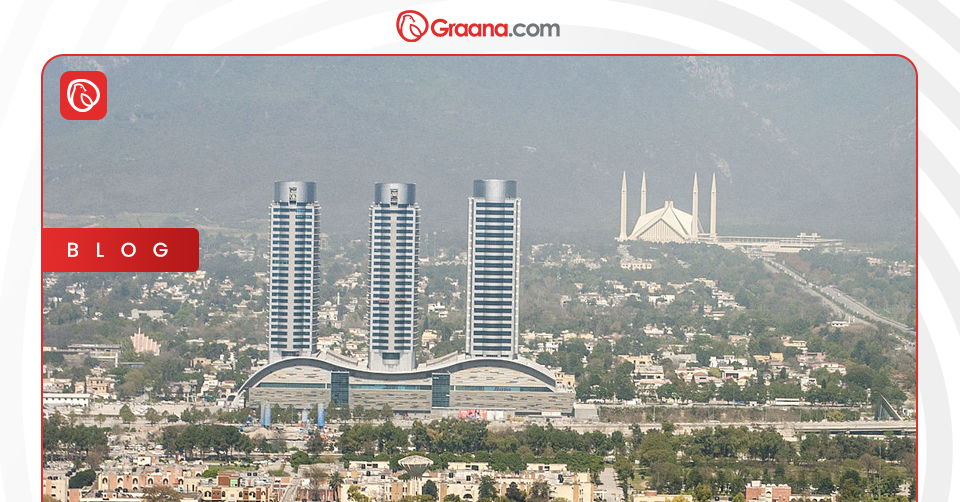
Source: Graana.com
Despite CDA’s celebrated reputation, the Federal Interior Minister highlights inconsistencies hindering progress in Islamabad’s development. With a new promise to address these issues and accelerate progress, what can the capital residents expect in the coming months?
In this piece, Graana.com offers a peek into Interior Minister Mohsin Naqvi’s vision of progress in Islamabad. Additionally, we will explore the effectiveness of this vision in advancing the capital’s development and enhancing its overall reputation.
Islamabad, Pakistan’s modern marvel, has meticulously planned avenues and designated sectors for residences and businesses. The Capital Development Authority (CDA) is the mastermind behind this architectural feat. As the prime mover of Islamabad’s development, CDA oversees everything from the construction of busy highways to the allocation of land for your dream home.
However, Islamabad’s development narrative isn’t without its hiccups. While the CDA has delivered on numerous projects, propelling the city forward, some sectors present a contrasting picture.
Here, entire areas have been frozen in time for over two decades. Residents who invested in plots with aspirations of building their lives there now find themselves waiting in exasperation. Plots remain undeveloped; dreams remain unrealized.
Here’s a look into areas that show signs of delayed development in Islamabad:
These sectors, often located on the outskirts of Islamabad, were allocated plots decades ago but remain largely undeveloped. Examples might include sectors like I-12, I-13, or I-14.
Even in some developed sectors, essential infrastructure projects like proper sewage systems, paved roads, or electricity grids might be incomplete or entirely absent. This can significantly hinder the liveability of these areas.
Delays can also arise due to legal complications or unclear land ownership within a sector. This can stall development projects while residents wait for resolutions.
Some sectors might have seen some residential development but lack essential commercial areas like shopping centres, banks, or hospitals. This inconveniences residents who have to travel to other areas for daily needs.
This issue recently came to light during Federal Interior Minister Mohsin Naqvi’s visit to the CDA headquarters. Imagine Minister Naqvi championing progress and bringing these stagnant sectors back into focus.
His message was clear and direct: these stalled projects needed immediate attention. It was a call to action, urging the CDA to address the plight of these neglected areas and get Islamabad’s development story back on track.
Federal Interior Minister Mohsin Naqvi’s recent visit to the CDA marked a turning point in addressing Islamabad’s development delays. His clear directives outline a multi-pronged approach to accelerate progress and tackle long-standing issues. Let’s delve deeper into the proposed resolutions and their potential benefits:
One of the most pressing concerns regarding development in Islamabad is the issue of undeveloped sectors with residents waiting for their plots. A proposed solution to this problem is to provide plots to those who have already paid the dues.
This will not only address residents’ grievances but also tap into the potential of these stagnant sectors. Developed residential areas contribute to the city’s economic growth by attracting new residents and businesses.
Minister Naqvi’s call for digitising Islamabad’s real estate records within six months signifies a critical step towards improving transparency and efficiency within the CDA. A digital land record system offers numerous benefits:
The Minister’s emphasis on completing the work on creating cycling and walking tracks on green belts highlights the importance of promoting a healthy and sustainable lifestyle for Islamabad’s residents.
These tracks will enhance the usability of green spaces and encourage residents to embrace eco-friendly modes of transportation. This can contribute to reducing traffic congestion and air pollution in the city.
The proposed high-speed one-window system within the CDA aims to simplify and expedite the process of obtaining approvals for development projects. This system will likely function as a single point of contact for all necessary approvals, streamlining communication and reducing bureaucratic hurdles. Benefits include:
Overall, Minister Naqvi’s proposed resolutions offer a roadmap for accelerated progress in Islamabad’s development. By addressing these concerns, CDA can potentially improve the quality of life for its residents.
With these directives, the CDA has a clear roadmap to promote Islamabad’s development. The capital’s residents can look forward to faster development, improved land management processes, and a more citizen-friendly CDA. Could this start a nationwide push for effective development processes and citizen-centric services? Only time will tell, but Islamabad’s CDA is certainly taking a step in the right direction.
Take a look at what most people ask about Islamabad’s development.
Pakistan’s capital, Islamabad, sits in the country’s northern part on the Pothohar Plateau. Established within the Islamabad Capital Territory, this meticulously planned city is divided into designated zones and sectors. In 2020, Islamabad achieved a noteworthy ranking as a Gamma+ world city.
Aside from its beautiful peaks, the city is brimming with historical and architectural treasures. Some examples are Shakarparain, Faisal Mosque, Margalla Hills National Park, The Monument, and Democracy Square.
Islamabad features a unique layout that was planned by architect Doxiadis. The city is divided into 84 sectors using a grid system with blocks measuring 2 kilometres by 2 kilometres. This grid is further complemented by a “natural grid” formed by the ravines that flow through the city’s landscape.
The CDA is launching a new online system that will provide a computerized record of land ownership and development plans across the city. This user-friendly platform offers several benefits:
Want to learn more about real estate? Head on to the Graana blog.
ISLAMABAD: The Capital Development Authority (CDA) has recorded a historic development expenditure of Rs25 billion…
ISLAMABAD: The federal government is set to inaugurate the Islamabad Information Technology Park on August…
Lahore, April 23, 2025 – The city of Lahore has successfully completed the construction of…
ISLAMABAD, Pakistan – April 23, 2025 – Chaaye Khana, Pakistan's popular cafe renowned for its…
ISLAMABAD: Prime Minister Shehbaz Sharif laid the foundation stone for the Murree Road underpass on…
DUBAI: Pakistani real estate developers and representatives showcased a range of commercial and residential investment…